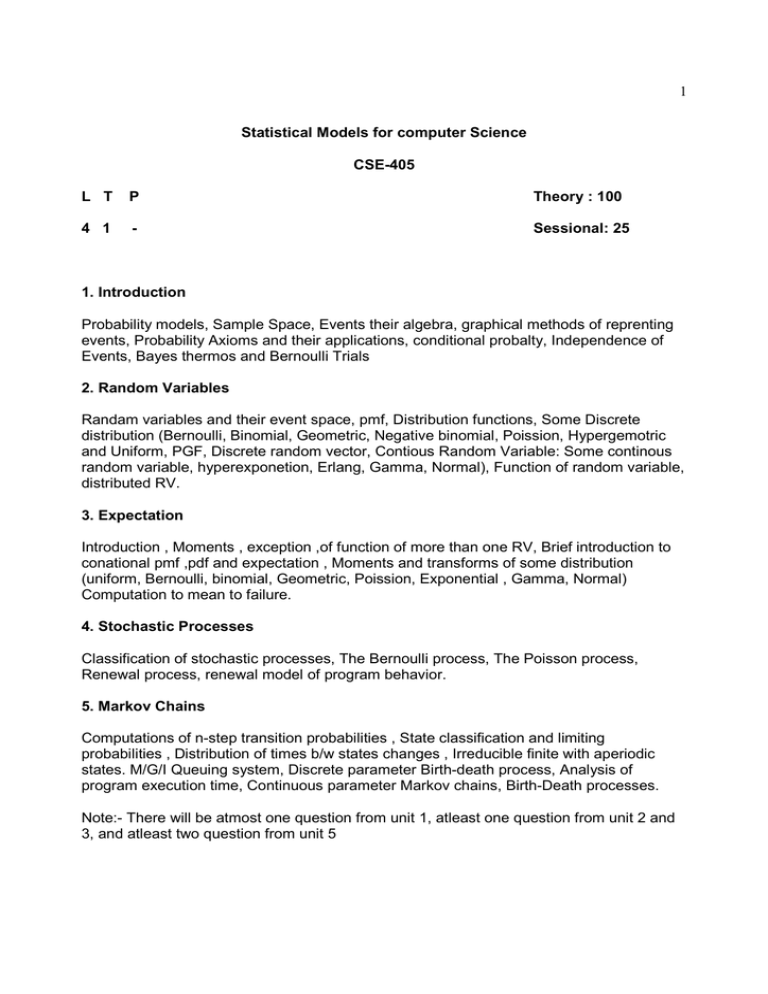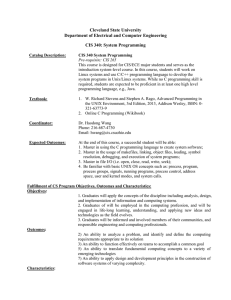1 Statistical Models for computer Science CSE-405
advertisement

1 Statistical Models for computer Science CSE-405 L T P Theory : 100 4 1 - Sessional: 25 1. Introduction Probability models, Sample Space, Events their algebra, graphical methods of reprenting events, Probability Axioms and their applications, conditional probalty, Independence of Events, Bayes thermos and Bernoulli Trials 2. Random Variables Randam variables and their event space, pmf, Distribution functions, Some Discrete distribution (Bernoulli, Binomial, Geometric, Negative binomial, Poission, Hypergemotric and Uniform, PGF, Discrete random vector, Contious Random Variable: Some continous random variable, hyperexponetion, Erlang, Gamma, Normal), Function of random variable, distributed RV. 3. Expectation Introduction , Moments , exception ,of function of more than one RV, Brief introduction to conational pmf ,pdf and expectation , Moments and transforms of some distribution (uniform, Bernoulli, binomial, Geometric, Poission, Exponential , Gamma, Normal) Computation to mean to failure. 4. Stochastic Processes Classification of stochastic processes, The Bernoulli process, The Poisson process, Renewal process, renewal model of program behavior. 5. Markov Chains Computations of n-step transition probabilities , State classification and limiting probabilities , Distribution of times b/w states changes , Irreducible finite with aperiodic states. M/G/I Queuing system, Discrete parameter Birth-death process, Analysis of program execution time, Continuous parameter Markov chains, Birth-Death processes. Note:- There will be atmost one question from unit 1, atleast one question from unit 2 and 3, and atleast two question from unit 5 2 Books: 1 K.S TRIVIDI,Probability, STATSTICS With Reliability,Queing and Computer Science application 2 J.J Hayes, Modelling of Commucation Networks , Khanna 3 W.Beller. AN introduction to probability Theory and its applications Queuing Systems 2 vols John Wiley 1976 3 SOFTWARE PROJECT MANAGEMENT CSE – 441 (Departmental Elective – II) L T P Theory : 75 3 1 - Sessional: 50 1. Convectional Software Management. Evolution of the software economics , improving software economics, reducing product size, software processes, team effectiveness, automation through software environments, principles of modern software management 2. Software Management Process Frameworks lifecycle phases- inception, elaboration, construction and training phases Artifacts of the process / the artifacts sets , management artifacts, engineering artifacts, pragmatic artifact, model based software artifact, work flows of the process, checkpoints of the process. 3. Software management Disciplines Iterative process planning, project organizations and responsibilities, process automation, project control and process instrumentation/core matrix, management indicators, life cycle expectations , process discriminates. Note: There will be eight questions in all at least from each unit. Books: 1. Software project Management , Walker Royee, Addison Wisley 2. Project Management 2/e Maylor 3. Managing the Software process , Humphrey 4. Managing global software projects, Ramesh, TMII, 2001. 4 Unix and Linux Programming CSE – 471 (Departmental Elective – III) L T P Theory : 75 3 1 - Sessional: 50 1. Linux Startup User accounts, accessing Linux-starting & shitting processes. Logging in & Logging out, Command line, Simple commands. Shell Programming Unix file system: Linux/Unix files, inodes and structures and file system related commands, shell as command processor, shell variables, creating command substitution,scripts,functions,loops,conditionals,loops,customizing environment. 2. Regular Expressions and Filters Introducing regular expressions patters, syntax, character classes, quantifiers, introduction to egrep,sed, programming with awk & perl. 3. The C Enviornment The C compiler , vi editor ,compiler options, managing projects, memory management, Use of makefiles, dependency calculations, memory management-dynamic & static memory, building & using static and dynamic libraries,using idd, soname, dynamic loader, debugging with gdb. 4. Processes in Linux Processes ,starting and stopping processes, initilization processes,re and init files,job control-at ,batch, cron, time, network files,security, privileges, authentication, password administration administration, archiving, signals & signal handlers, Linux I/O system. NOTE:-There will be 8 questions in all.At least one question will be set from each of the units. BOOKS 1.John Goezzen:Linux Programming Bible,IDG books,New Delhi,2000. 5 2.Sumitabha Das:Your Unix-The Ultimate Guide,TMH,2000. 3.Mathew Proffessional Linux Programming,vol. 1 & 2,Wrox-Shroff,2001. 4.Welsh & Kaufmann:Running Linux,O’Reiley & Associates,2000. 6 Web Engineering CSE-403 L T P Theory: 75 3 1 - Sessional: 25 1. Information Architecture The role of the Information Architect, Collaboration and Communication, Organizing Information, Organizational Challenges, Organizing Web sites and Intranets, Creating Cohesive Organization Systems Designing Navigation Systems, Types of Navigation systems, Integrated Navigation Elements, Remote Navigation Elements, Designing Elegant Navigation Systems, Searching Systems, Searching your Web Site, Designing the Search Interface, Indexing the Right Stuff, To search or Not To Search, Grouping Content, Conceptual Design, High-Level Architecture Blueprints, Architectural Page Mockups, Design Sketches. Dynamic HTML and Web Designing HTML Basic Concepts, Good Web Design, Process of Web Publishing, Phases of Web Site development, Structure of HTML documents, HTML Elements-Core attributes, Language attributes, Core Events, Block Level Events, Text Level Events, Linking Basics, Linking in HTML, Images and Anchors, Anchor Attributes, Image maps, Semantic Linking Meta Information, Image Preliminaries, Image Download Issues, Image as Buttons, Introduction to Layout: Backgrounds, Colors and Text, Fonts, Layout with Tables. Advanced Layout: Frames and Layers, HTML and other media types. Audio Support in Browsers, Video Support, Other binary Formats. Style Sheets, Positioning with Style sheets. Basic Interactivity and HTML: FORMS, Form Control, New and emerging Form elements. CGI using PERL Introduction to CGI, Alternative Technologies, The Hypertext Transport Protocol, URLs, HTTP, Browser Requests, Server responses, Proxics, Content Negotiation, The Common Gateway Interface. The CGI Environment, Environment Variables, CGI Output, Forms and CGI, sending Data to the Server, Form Tags, Decoding Form Input, Architectural Guidelines, coding Guidelines, Efficiency and Optimization. Java Server Pages Basics, Integrating Scripts in JSPs, JSP Objects and Components, configuring and troubleshooting, JSP: Request and response objects, Retrieving the contents of a an HTML form, Retrieving a Query String, Working with Beans, Cookies, Creating and Reading Cookies. Using application Objects and Events. 7 XML Relationship between HTML, SGML , and XML , Basic XML , Valid document, Ways to use XML, XML for data Embedding XML into HTML Documents , converting XML to HTML for displaying . Displaying XML using CSS and XSL . Rewriting HTML as XML. The future of XML. Note : At least one question will be set from each unit Books: 1. Thomas A Powell HTML The Complete Refference TMH Publication. 2. CGI Programming with Perl 2/e, Scott Guelich, Shishir Gundavaram, Gunther Birzniek; O’Reilly. 3. Doug Tidwell, James Snell, Pavel Kulchenko; Programming Web Services with SOAP, O’ Reilly. 4. Pardi, XML in Action, Web Technology, PHI. 5. Young XML Step by step PHI. 6. Aaron weiss , Rebeeca Tapli , Kim daniels stuven mulder jeff kaneshki, Web authouring Desk Reference Techmedia Publication. 8 Compiler Design CSE-401 L T P Theory: 100 4 1 - Sessionals: 25 Unit-I Introduction and types of assemblers, linkers, loaders, compilers and translators, the structure of a compiler, different states in the construction of a compiler. Design of lexical analyzer. Parsers, shift reduce parsing, operator-precedence parsing, top down parsing, predictive parsers. L. R. Parsers, the canonical collection of LR(0) items, construction of SLR parsing tables, constructing canonical LR parsing tables, constructing LALR parsing tables, implementation of LR parsing tables. Unit-II Syntax Directed Translation Syntax directed translation schemes, implementation of syntax directed translators, intermediate code, postfix notation, parse trees and syntax trees, three address code, quadruples and triples, translation of assignment statements, boolean expressions, control statements. Symbol Tables The contents of a symbol table, data structures for symbol tables, representing scope information. Unit-III Run time storage administration Implementation of a simple stack allocation scheme, implementation of block structured languages, storage allocation in FORTRAN, storage allocation in block structured languages. Error detection and recovery 9 Error, lexical – phase errors, syntactic phase errors, semantic errors. Unit- IV Introduction to code optimization The principal sources of optimization, loop optimization, the DAG representation of basic blocks, value number and algebraic laws, global data flow analysis. Code generation Object programs, problems in code generation, a machine model, a simple code generator, register allocation and assignment, code generation from DAGs, peephole optimization. Note:- At least one question will be set from each unit. BOOKS:1. Aho A. V. & Ullman J. D.: Principles of Compiler design, Addison Wesley 2. Donovan J. : System programming, TMH 3. D. M. Dhamdhere: Compiler construction- principles and practice, Mc Millan India. 4. David Gries: Compiler construction for digital computer. 10 Unix and Linux Programming (Pr.) CSE – 407 L T P Practical: 50 - Sessional: 50 - 3 1. Familiarize with Unix/Linux logging/logout and simple commands. 2. Familiarize with vi editor and Linux GUIs. 3. Using Bash Shell develop simple shell programs. 4. Develop advance shell programs using awk and grep. 5. Compile and debug various C programs using different options. 6. Learning of installation and upgradation of Linux operating system. 7. Install Linux on a PC having some other previously installed operating system. All OS’s should be usable. 8. As supervisor create and maintain user accounts, learn package installation, taking backups, creation of scripts for file and user management, creation of startup and shutdown scripts using at, cron etc. 11 Web Engineering (Pr) CSE – 409 L T P Practical: 50 - Sessional: 50 1. 2. 3. 4. 5. 6. 7. 8. 9. 10. - 3 Chalk out the storyboard and design of Dairy Food Limited. As the name reflects your site provides dairy products and aims at opening an online store. Your storyboard should cover all the features that you plan to have on the site. Create your own page with your favorite hobbies. Create a Menu or a Table of content web page. Each menu item on section of the table of content should load a different web page. For example, if the user clicks on Menu one or section 1 then the link should take him to the respective menu html or section and so on. Create a web site for your college. Create a frameset that is divided into three sections. The frame set should have three zones. The topmost section of the frameset should take up just about 15% of the browser window. Name this frame title. The middle section should be 70% of the browser window. Name this frame title. The lower most sections should also be about 15% of the browser window. Name this section as menu. Create pages for each section. For the lowermost section, create page that loads the content into the middle section. the topmost section should contain a page describing the web page itself. Create a web page which displays the map of your country link, each state /city on the image using image map such that the respective html page of the city/state is displayed when the user selects an area. Add the tickertape applet to your page by customizing it for the following settings: Increase the count by one. Accordingly update the message count. Change the text color to (237, 192, 171) Experiment with changing the scrolling speed. Customizing the message text as per your page requirement. 11. Incorporate a quest book into the dairy food webpage and use Java script to build validations into the form. Use style sheet to modify the following: 12 Change the background to modify the following. Change font, type, face and color. Align text. Remove underlines from hyperlinks. Use Microsoft’s Personal Web Server to set up your web site.




